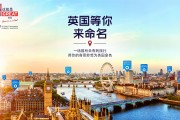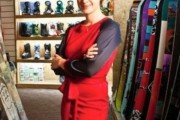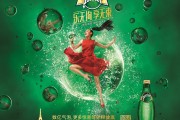Here in the advertising section of chinaSMACK we like to support Chinese brands. One company that caught our eye is Plastered, an independent Chinese t-shirt brand that specialises in creating apparel which captures the “essence of China”.
Established in 2006, the brand first appeared in Plastered’s concept store in Beijing. The little shop on the capital’s South Luo Gu Alley soon grew very popular with the locals. But Plastered propelled itself to wider fame by launching China’s first ever hutong (a traditional Chinese alleyway) catwalk show:
The hutong catwalk show The Plastered brand was then picked up by the likes of Vogue and Elle, and has since gone from strength to strength. Most recently the company celebrated its 5th Anniversary with a big party.
But who is behind this quirky Chinese fashion brand? Some local Beijinger?
Nope, not quite. It is in fact a chap called, Dominic Johnson-Hill — a rather entrepreneurial Briton living in Mainland China. We caught up with Dominic to find out more about Plastered and his views on the creative industry in China…
Nǐ hǎo and hello Dominic, as with all ex-pats we have to ask, what brought you to the Middle Kingdom?
I came to China is 1993 as a back packer, I had been traveling for about 3 years around the world doing odd jobs and wanted to basically discover the world. After seeing the Great Wall I ran out of money so I started to look for work around Beijing and it was surprisingly easy at the time. I never expected I’d still be here 18 years later.
So how did Plastered come into existence? What gave you the idea? Was it difficult to setup?
Being a westerner living in China so long and wanting to pursue an entrepreneurial life you see a lot of opportunity… markets/ideas from the West that have yet to develop in China. In 2005 I was walking down a quiet Hu Tong where I lived in old Beijing and saw someone wearing one of those classic iconic t-shirts with a drawing of the Great Wall and the slogan “I Climbed The Great Wall” written on it.
I can remember thinking that I bought that same ugly T-shirt back in 1993 and all this time no one had started a good Beijing t-shirt brand, celebrating iconic Beijing/China images. So I decided to play with this design by slapping a woman in a bikini on top of the Wall design. This idea, however strange and unpopular it was with my first customers, was the start of the brand; everything came from that idea. I never expected the brand to be so successful and it’s been a fun ride so far.
Setting up Plastered had its difficulties. I started the brand with about 40,000 RMB ($5,000 at that time) and opened a small shop on the quiet alley where I lived. That alley is now one of the most famous shopping destinations in Beijing – Nan LuoGu Xiang.
After about 2 years of running Plastered with good growth I had the money to register my own legal business, and move to a bigger location on the same alley.We now sell out of another location in one of Beijing’s art districts (798), and in Shanghai.
Working in the heart of China’s creative industry must be exciting, what do you think are the greatest strengths but also challenges of China’s creative industry?
To be quite honest, the creative industry in China, especially in the field I’m in, is very small. I know many of the creative graphic designers in China through all the collaborations we do to create our artwork. The greatest challenge to this industry is that people view it as on the periphery – that design and creativity is something for only a minority of people that choose a sort of alternative lifestyle – which totally isn’t true!
This probably stems from the way children are educated in China in that creativity is not necessarily valued or cultivating in the schools here. In addition to this, the one child policy puts a lot of pressure on each child to really perform, and make it into the “right” university, and ultimately earn money. The pressure is intense. This environment does not really facilitate creativity.
Finding creative designers in China even 5 yeas ago was very tough. I have noticed that more kids are choosing their own paths and some choosing their passions in art and design.Most of these kids, the ones pushing the creative industry in China, were born in the 80s and 90s, into much more financially stable times (in the major cities that is). I have a network of designers I work with now from all over China and they are as good as any designers you’ll find anywhere else in the world.
Do you think Chinese citizens have the freedom to express themselves creatively? Is the Ai WeiWei saga an exception or a typical example?
I’d say that I keep politics out of my t-shirts. I can say that I work with a lot of young creative artists who are changing the creative landscape of China. I have faith in this generation of creative thinkers and artists.
Moving onto advertising, do you create your own advertising, or do you use an ad agency?
I create all my own advertising and it’s always guerrilla. We started the business with a very small amount of money and never had the kind of budget you would need to pay an advertising agency. Marketing is one of my passions; I am always trying to think of ways to get in front of people and tell them about the brand.
We started with rude sticker campaigns for examples (we handed out stickers with swear words on them and our logo and basically encouraged people to Plaster them around town), we gave out our t-shirts to local characters who lived/worked on the hutong (above-mentioned alley where shop is located) who walked the hutongs, we held illegal catwalk shows in Beijing’s old hutong district, we got rock stars and celebrities to wear our gear by knocking on their doors and telling them about the brand (and giving them free t-shirts).
Print media is very expensive and to be honest I don’t feel that effective for a brand like mine. We like to create original content that will leave a lasting affect on the person who sees it. Recently we’ve moved into online viral videos (example below) as advertising – with great success. We have a lot of fun making the videos and playing around in Beijing while doing it.
A Plastered viral advertisement
What do you think of Chinese advertising in general? What kind of advertising do Chinese consumers connect with?
It’s a fairly young industry and I am no expert on it. Infomercials are hilarious on Chinese TV: pills that make women’s breasts grow, stretching machines that look like their from Medieval times that can help you grow inches in a week, all very impossible but yet all over television. Chinese consumers are chasing the dream of a villa home, a fancy car and a beautiful partner and a perfect child, its very obvious stuff really but that’s cause it’s a young market.
An amusing Chinese infomercial being reviewed by Ellen
Chinese adverts can be very aggressive and it seems to be working so far! Some short 5 second television adverts can run 3 times in a row leaving you with the feeling of being brain washed or confused…. at least as a Westerner that’s how I feel.
On China’s biggest search engine Baidu the search results are sponsored, with Google the sponsored ones are highlighted so you know what’s what, but with Baidu you can pay to be at the top of the listings. In fact some companies who get high listings through popularity are asked to pay or get knocked down. It’s a tough market. Also, please note that I am commenting on 100% China advertising, not Chinese advertising that is sourced from international companies in China like Apple, or Nike, etc. Li Ning is an example of how Chinese brands take ideas and inspiration from the west. Li Ning’s logo is very similar to the Nike “swish” and their slogan “Anything is Possible” is very similar to Adidas’s “Impossible is Nothing”.
Many Westerners feel that Chinese creativity, in particular advertising, is rarely original. What are your thoughts on this statement?
I would say it’s very innovative. They have taken elements of advertising from the west and played with them to suit the Chinese market, and why not? Historically you can see how Japan successfully took western ideas in business and improved on them, the Chinese can do the same but where does one draw the line? Is it straight up copying or is it innovation?
There’s not an awful lot of respect for IP here, everyone is copying each other. It’s tough being in the creative business in China – you have to continually to re-create or get gobbled up. The Chinese are creative, without a doubt, but as I touched on earlier, I think the creative industries here with blossom as the country becomes more affluent. I know with myself that the more time I have to daydream, and relax, the more creative I can be.
Who would you say are the Top 5 Chinese creative groups / individuals to look out for in 2011?
1. Liú Xiǎodōng (刘小东) – An artist / painter.
2. Queen Sea Big Shark (后海大鲨鱼) – An amazing band with real talent.
3. Neocha.com – A great creative blog that can keep you up to date on the creative scene in China.
4. Reflector (反光鏡楽隊) – A band we’ve worked with many times before, and this year own the Best Band in China award, they are really on fire right now.
In November 2008, you were awarded “British Entrepreneur of the Year in China”. Congratulations – you must be a man with a plan. To that end, how do you hope to progress the Plastered brand in the next five years? Would you like it go global?
Never had a plan, just a lot of passion and tons of energy. I wrote my first business plan last year and Plastered is 5 years old this May. It was a big surprise to win that award, something I never expected considering the people I was up against.
My favourite moment from that was flicking a royal “screw you” V during the picture with Prince Andrew during the official photograph and then making it into the China Daily the next day only to have my arm cut off by the photo editors and my face replaced with another photo where I was smiling! All good fun!
The next 5 years are going to be exciting. I do a lot of TV appearances in China (Dominic in Chinese media) so the brand has real legs now. Traveling to 1st and 2nd tier cities around China I get recognized a lot and people love the brand. The plan is to take the brand to more cities and create the same creative, community, and fun feel we have done in Beijing and Shanghai.
So initially more bricks and mortar expansion and then continue to grow our web sales internationally via our site plasteredtshirts.com and our B2C site on the Chinese ebay- taobao.com. We have seen huge growth on our taobao site this year.
A big part of the next five years is to further develop and source Chinese artists to work with Plastered. The community of artists that is growing around Plastered is very impressive and we want to build on that as we expand throughout the country. The plan is to have a strong network from which we can source the most creative, meaningful artwork for cities across China.
Yes we’d love to take Plastered worldwide. We have done some licensing deals to the UK and wholesale to Europe and USA. I’d like to be the guy who takes cool creative Chinese artwork to the West – that would make me very proud.
Thank you Dominic and xiè xiè.
Don’t forget to like us on Facebook.
.















